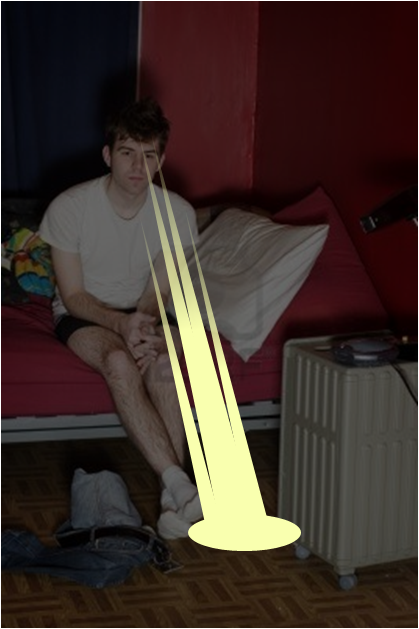Neutrinos — what if we could see them?
What if we could see neutrinos?
Let’s imagine that your eyes could magically see neutrinos. Never mind the fact that all regular matter is pretty much transparent to neutrinos – no wait, on second thought let’s keep that fact intact, because it’ll lead us somewhere cool. Keep all matter transparent to neutrinos except your eyes, which somehow can see them. How bright would the sun be, if we could somehow see it in neutrinos?
This article goes into a bit more mathematical / scientifical detail than yer typical timeblimp.com article, so if you’d rather not know how I did it, skip down below to “the bottom line” to see the answer.
Show your work
Remember the solar neutrino flux? About 1011 neutrinos flow through every square centimeter every second, given how far we are from the sun. (Out at Pluto’s orbit, the flux is lower, since at that far distance the neutrinos are more spread out.) The “energy flux” from everything the sun outputs is about 1366 watts / m2 (which is the “solar constant”) – that’s how much total energy we get from the sun per meter squared, at our distance from the sun. But since the earth’s surface is curved, we actually get about 342 watts / m2 of solar energy per meter squared on the earth’s surface (given that most of the surface isn’t at right angles to the sun at any given time). About 30% of that energy is in visible light. Dividing by the energy of one representative visible-light photon at 500 nm, gives us about 2.6 x 1016 visible light photons per square centimeter from the sun every second. So the visible-light flux is a lot more than the neutrino flux.
But what about the moon? Assuming the moon gets the same visible-light flux as we do (since it’s at pretty much the same distance from the sun, and is also a sphere), we can figure out how much of the sun’s light the moon reflects our way. The moon has an albedo of somewhere around 10%, meaning that it reflects about 10% of the light that hits it. Since it reflects that in all directions, not just to earth, we have to do the ol’ r-squared distance correction to find that the moon sends us about 5.6 x 10^10 visible-light photons per square centimeter, originally from the sun.
That’s pretty close to the neutrino flux from the sun, actually! Yeah, it’s off by a factor of 2 or so, but that’s close enough, relatively speaking. First of all, our eyes perceive brightness over a very wide dynamic range, so a number flux going up or down by a few multiples probably doesn’t change the apparent brightness much. Second of all, there’s no way I did all these estimates without making a mistake of at least a factor of two. So I’m prepared to say that the number flux density of neutrinos from the sun is approximately equal to the number flux density of visible light from the moon.
What else out there in the night sky might shine in neutrino-vision? Not much, but there is one other famous emitter of neutrinos – supernovas. Back in 1987, we were lucky enough to witness a supernova that was close enough to see with the naked eye. (Unfortunately for a young timeblimp, it was only visible from the southern hemisphere.) Supernovas emit a ton of radiation, and not only in visible light – they spit out a vast number of neutrinos into the universe, so if you have neutrino-vision, you might be able to see them. A couple hours before we could see the 1987a supernova (i.e. before its visible light reached us), we saw a blinding flash of neutrinos – an epic amount, a deluge never before observed in recorded history. Yes, a whopping 24 neutrinos were detected. Thunderous, eh? Given how many neutrinos they typically observed using neutrino detectors back in 1987, that actually was a stunning number of neutrinos to see in the span of a couple hours.
So how bright would it be if we could see it? Yer typical supernova will be temporarily brighter than the rest of the entire galaxy it sits in, when its at the peak brightness. Which makes it all the more astounding that about 99% of the total energy emitted by the supernova is in neutrinos, stuff we can’t visibly see. The 1987a supernova emitted an unbelievably large number of neutrinos – scientists estimate that a grand total of 10^58 neutrinos got blown out into the universe in the explosion. But it was pretty far away – 168,000 light years away, in another galaxy entirely. Nevertheless, that’s such an astounding number of neutrinos, that by the time they reached earth, there were still 3 x 10^14 neutrinos per square meter passing through the earth. That works out to be about half of the neutrinos we get from the sun! If that sounds like not that much, let me remind you – THIS THING IS 168 THOUSAND LIGHT YEARS AWAY IN ANOTHER GALAXY. Since we already worked out how bright the sun is in neutrino-vision, this supernova would be almost as bright as that – maybe a smidge dimmer than the full moon in visible-range light.
The bottom line
So, if you could somehow see neutrinos, the sun would look about as bright in “neutrino vision” as the moon does to us in visible light. Well fine, but so what? Well, neutrinos fly right through normal matter as if it was wispy fog, streaming straight through the earth as if it wasn’t there. So you’d see the sun in “neutrino vision”, regardless of whether the sun was above or below the horizon! After the sun sets in the evening, the sun would remain just as bright, shining with nary a dimming as the earth moves in between you and the sun. Later on in the evening, a few hours after sunset, you’d still see the sun, shining up from the floor, just as bright as it was at noon. The sun would be a spooky, ever-present bright spot in your field of view, about as bright as the full moon, no matter where you were or what time it was. At 3 am, when you like to go sit in a bank vault 3 stories underground, you could look around and still see the sun, shining up at you through the floor. Great googly moogly!
I find that really weird. Never mind the fact that we can’t actually see neutrinos, and have no conceivable way to build “neutrino goggles” that could see in neutrino-vision much like night vision or something. After all, neutrinos barely notice the entire earth – how the hell are they going to be absorbed by your retina, or any detector you could come up with? And if you could somehow get yourself some neutrino-vision, you would only be able to see the sun (and more faintly, other stars), as the vast majority of neutrinos around us are coming from the sun. Since neutrinos wouldn’t deflect off other objects into your eyes (as sunlight does to enable us to see objects in daylight). So to be fair, this image I have in my mind of a creepy, glowering, unblinking floor-sun is really in visible light and neutrino-vision.
By the way, if you happen to be a few tweaks away from perfecting your invisibility spray, keep in mind that if you make yourself completely invisible (so that light passes right through you), you’ll also make yourself blind – since your eyeballs don’t intercept any light, they won’t pick up any light either, which is pretty much essential to vision.
We’ve learned that neutrinos don’t like to hang out much. They almost always pass right through us without noticing. But every once in a while they do make themselves known…
Next Up: How many neutrinos collide with our bodies? >>



 Follow Timeblimp on Twitter
Follow Timeblimp on Twitter